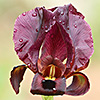Dark-purple iris is a geophyte from the Oncocyclus irises group. It has a 1 cm thick branched rhizome. Each branch produced a tuft of flat straight or curved leaves, arranged in two opposite positions. The rhizomes from clumps of genetically identical plants (clones) each covering up to a square meter.
Among the leaves grows a 20-40 cm long stem bearing a single large (8 cm diameter) flower covered at beginning with a membranous spathe. In each population there is a considerable variation of flower colors, from dark-purple to brown and even yellow. The perianth includes six petals in tow whorls of 3. The outer petals are wide curved spatulate, bent downwards. At their bases there is a dark velvety spot in front of a group of bright yellow hairs. The ones of the inner whorl are erect curved inwards forming a dome-like structure. Between elements of the inner and the outer whorls minute tunnels are formed inside each of them a single stamen and a lobe of the stigma. The entrance to these tunnels is marked by the yellow hairs, mentioned, above, that stand-out on the background of the dark petals. These tunnels are used as a shelter and a sleeping-quarters by pollinating insects, mainly males of solitary bees of the genus Eucera. The fruit is a three-cell fusiform capsule. Flowering season is January to March.
Dark-purple iris, like a number of species in the Oncocyclus section is endemic to a certain are in the land of Israel, the sandstone ridges of the coastal plane from Atlith in the north to Ashkelon in the south. It appears in isolated populations composed of many dense clumps. It is protected by Israeli law.
Written by Erga Aloni






